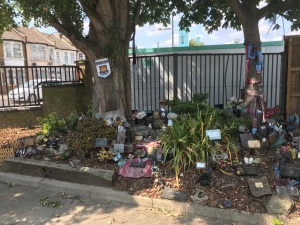It’s not often that a giant magical tree stars in a Hollywood mega blockbuster film. And what could possibly connect it to a key story in the transformation of Northern Europe from pagan-worshippers to Christians? These are the kinds of thoughts which wash around my brain after an invigorating mental workout at the Oxford Real Farming Conference, about which I wrote last week.
The film in question is director James Cameron’s 2009 blockbuster Avatar, where the very tall blue indigenous people of the planet Pandora live in their sacred Home Trees. One of these is deliberately destroyed by the colonising humans, who are intent on obtaining access to an unimaginably valuable mineral resource which sits under the tree.
There are other even more sacred (and magical) trees in Avatar – and I wonder whether James Cameron was influenced at all by the story of St. Boniface. St. Boniface was a Christian missionary from Devon. Boniface’s original name was Winfrith – which by strange coincidence was the village chosen in the 1940s to host the UK Atomic power research facility, and just down the road from where I am writing.
Winfrith travelled to what is now western Germany to help with the conversion of the pagan Franks living in that part of Germany to Christianity. He found some continued to worship a sacred Oak tree, later called Jupiter’s or Donar’s Oak.
Boniface, with the help of some followers started to chop the immense tree down. Legend has it that as the first axe-cuts were made to the tree, a great wind blew up and split the enormous trunk into four equal pieces, imperilling the fellers. But Boniface emerged unscathed from the ruins and it was deemed a miracle. The pagans were so impressed by this miracle that they gave up their pagan beliefs. The tree’s timber was then used to build a church dedicated to St Peter, near the site of the sacred tree. Boniface went on to become one of the most significant founding figures of the Church in Western Europe.
A wave of desecration
This story neatly summarises centuries of activity, where sacred trees and other natural features, such as sacred wells and springs, were either expunged from the landscape, or appropriated into Christianity, at least until the 16th Century Reformation. At this juncture, the new Protestant faith rejected the false idolatry of shrines and images – and a further wave of desecration – literally meaning the removal of sacred objects – took place.
Have any sacred trees survived to this day, especially in our mainly secular society? You might be surprised that they do, and in the most unlikely places.
It’s coming up to the tenth anniversary of my father developing, what would be for him, a fatal form of cancer called Acute Myeloid Leukaemia. Peter was a lifelong, die-hard West Ham fan, having been born within a few hundred yards of the Boleyn ground in Upton Park, West Ham, in East London. His father had also been a fan, and had been part of the famous crowd at the first FA Cup final at the new Wembley stadium when the Hammers lost to Bolton Wanderers in 1923. There was such a large crowd (estimated at up to 300,000) present for that game that it spilled onto the pitch stopping the match.
Peter was not expected to survive the Leukaemia, but incredibly, he did and in the end had a little over a year’s extra time, before it returned – and he died in July 2010. During this time he had decided that he wanted his ashes to be spread on the pitch at Upton Park, as many lifelong Hammers fans do. When we approached the club they explained that this no longer happens (on account of the players not really wanting to tread on people’s ashes as they played) and that over the last few years, ashes had been interred around a large Lombardy Poplar tree near to the club entrance.
We duly arrived at the ground to meet the Chaplain, who performed a simple ceremony as we interred the ashes under the tree. Around the base of the tree were a small sea of plaques and other memento mori, all in memory of Hammers fans, whose ashes had been sent from all around the world, to return to their spiritual home.
The tree (and a younger one next to it) had been festooned, time and again, by the grieving relatives of Hammers fans, festooned with scarves, badges and other memorabilia. Time, and the ravages of the weather (and London street pollution) had left some of these as strands of wispy fabric caught in the bark of the Poplar. A rather forlorn looking garden gnome, in claret and blue sat, unblinking, at the base of the trunk. This was clearly a sacred tree.
I do not use the words “spiritually” or “sacred” lightly in this context. I would certainly not be the first person to draw an analogy between football and religion. As the legendary Liverpool manager Bill Shankly said:
“some people believe football is a matter of life and death, I am very disappointed with that attitude. I can assure you it is much, much more important than that”.
My dad wasn’t religious, indeed he was what I would call a fanatical atheist. But he had faith in West Ham, following them through thick and thin, through the glory years when West Ham effectively won the World Cup for England in 1996 – and also through many years of mediocrity and failure.
Football has many elements of a religion – a shared faith in something bigger than yourself – opportunities to sing together, the many rituals associated with thousands gathering at a place (of worship) every week. A place where you can forget the troubles and difficulties of daily life, for a couple of hours. Where there are heroes (and villains) to be worshipped – and also idols to knock off their plinths, when they fail.
When West Ham sold the Boleyn ground (for a housing development) and moved to Stratford, my mum and I were very concerned about what would happen to the tree and its sacred burial ground. After some cajoling, the developers (Barratts) committed to protecting the tree and creating a new memorial. They asked us for our views about what the memorial would look like and it was gratifying that they recognised how important this place, and that tree, had become.
Elsewhere in the world, you will find many examples, in a variety of different cultures, of sacred trees being venerated and dressed, as memorials for people, who were loved and lost. Despite living in materialist secular societies, we still have a deep need to find what I would call a spiritual connection to Nature.
As the West Ham tree shows so clearly, there is no need to formalise this relationship through religion – and few would argue that West Ham has any properties that one would associate with the supernatural. On one level this is about humans, and the things that we need – that Nature provides. Things like solace and the opportunity to remember our loved ones in ways that are healing and strengthening.
This article first appeared on Lush Times

